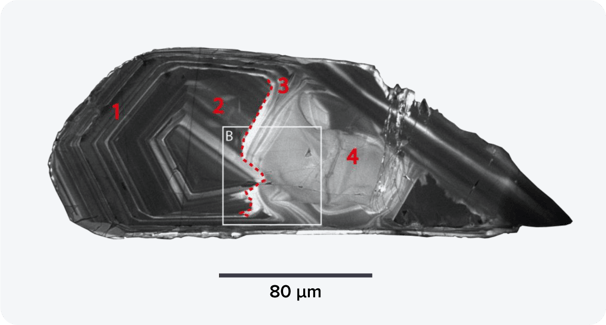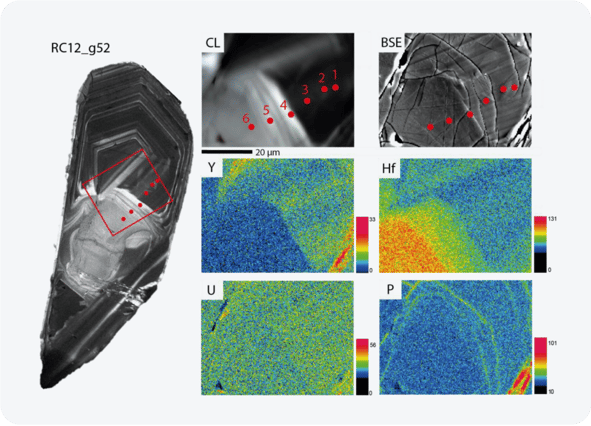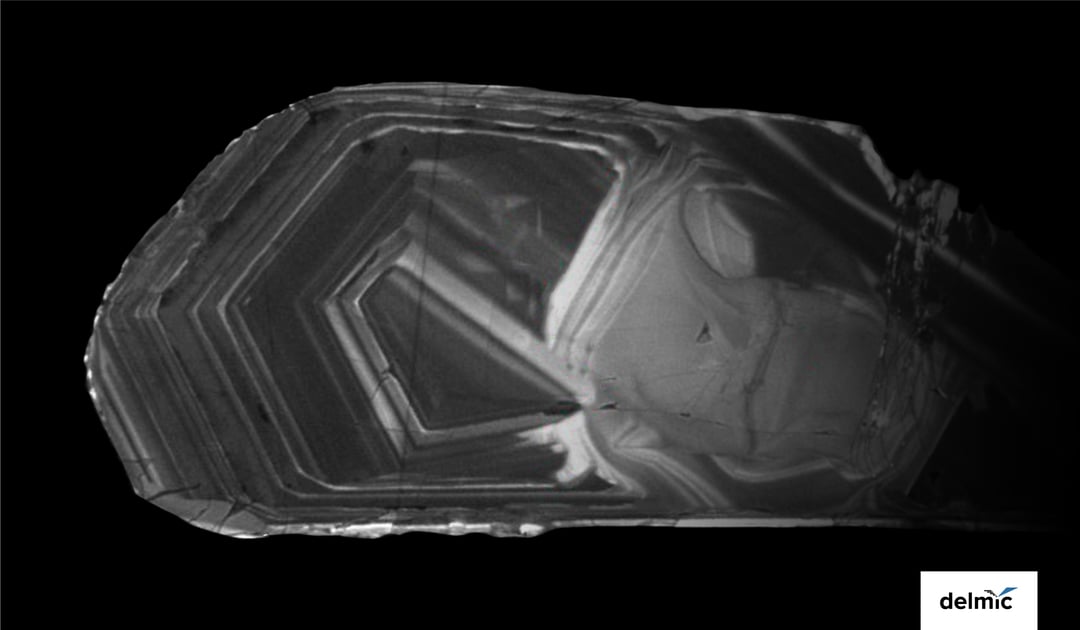Zircons are widely used in geochronological studies for dating geological processes, particularly through U-Pb dating [1]. This is mainly due to the following characteristics of zircons:
- Abundance
- Resistance to weathering
- Ability to incorporate trace elements
However, it has been observed that zircons undergo a process called recrystallization. This takes place after the primary crystallization of the zircon and can result in the removal of oscillatory zones, as well as the loss of U, Th, and Pb elements. Two types of boundaries between the zoned and unzoned zircons have been identified: the transgressive boundary, where the unzoned zircon forms intrusive patches within or at the boundaries of the growth zones, and the translational boundary, where a progressive transition from zoned to unzoned zircon occurs, causing the zones to fade [2].
Recrystallization mechanisms in zircons
Various models have been proposed to explain the mechanisms of recrystallization in zircons. However, the exact relationship between the recrystallization microstructures, compositional variations, and their impact on trace-element concentration and U-Pb dating remains poorly understood. To address this, Huijsmans et al. conducted a study investigating the microstructures of zircons obtained from three different localities [1].
To analyze the internal structure of the zircons, the researchers used Delmic’s SPARC Compact cathodoluminescence detector on a scanning electron microscope (SEM). The detected cathodoluminescence (CL) signal could reveal the different types of zoning within the zircons grains. It was found that oscillatory zoning differed between the samples, with some grains displaying bimodal zoning while others exhibited broader and fainter oscillatory zoning. Additionally, fractures were identified within the zircons using forescatter electron (FSE) imaging.
After that, the researchers examined the recrystallization microstructures using CL imaging. They found a significant replacement of zoned by unzoned zircon. Furthermore, the transgressive and translational boundary types were clearly recognizable within the zircon grain (Figure 1). The sharp interfaces between zoned and unzoned zircon can be accompanied by different microstructural features, such as a recrystallization font, fractures, and low-angle lattice misorientations.
Figure 1: CL image of one of the zircon grains. The numbers indicate the different textures related to the zircon recrystallization: 1) zoned zircon, 2) translational replacement, 3) convolute zoning, and 4) transgressive replacement. Adjusted from [1].
Subsequently, they investigated the chemical composition of the recrystallized microstructures. Within these microstructures, a higher concentration of Hf and a lower concentration of Y were observed compared to zoned zircon (Figure 2). There were no significant differences in the concentrations of other trace elements such as U and Th, which are important for U-Pb dating.
However, previous studies have indicated a heterogeneous distribution of these elements [3]. The researchers propose that this difference might be attributed to the analytical uncertainty of measurements and the generally low concentrations of these elements [1].
Figure 2: CL, BSE, and WDS maps of trace elements in grain RC12_g52, with microprobe spot measurements indicated as red dots. In the unzoned zircon (spots 4,5,6), Hf can be clearly seen to be enriched and Y to be depleted compared to zoned zircon (spots 1,2,3). P can be seen to be enriched in the fractions and U does not have significant variations in concentration. Adjusted from [1].
Proposing a hybrid model
Based on these observations and previous literature reports, they propose a hybrid model to explain the recrystallization of zircons. The accumulation of lattice dislocations during the recrystallization process appears to provide efficient channels for the migration of defect and trace elements. Some trace elements such as Y, U, and Th for instance, are expelled from the lattice during recrystallization, while Hf can enter the zircon structure and replace Zr.
Following this recrystallization, the resultant diffusion pathways can promote a second recrystallization event in which the dissolution and reprecipitation of zircon can further alter its chemical composition and microstructure [4].
This research shows that there are a wide variety of microstructures indicative of zircon recrystallization, such as fading of the oscillatory zoning and replacement of zoned with unzoned zircon. Complex zircon recrystallization events can lead to these various microstructures with heterogeneous distributions of trace elements.
So, Zircon recrystallization can influence U-Pb dating by heterogeneously distributing the trace elements.
Therefore, it’s crucial to take into account the accurate history of the recrystallization events in the studied zircons when performing U-Pb dating. Do you take recrystallization effects into account when using zircons for your geochronological studies?
References
[1] Huijsmans, J.R. et al., Minerals 12, 1489 (2022)
[2] Pidgeon, R.T., Contrib. Mineral. Petrol., 110, 463–472 (1992)
[3] Peterman, E.M., et al., Contrib. Mineral. Petrol. 174, 92 (2019)
[4] Geisler, T. et al., Elements, 3(1), 43-50 (2007)
.png)









